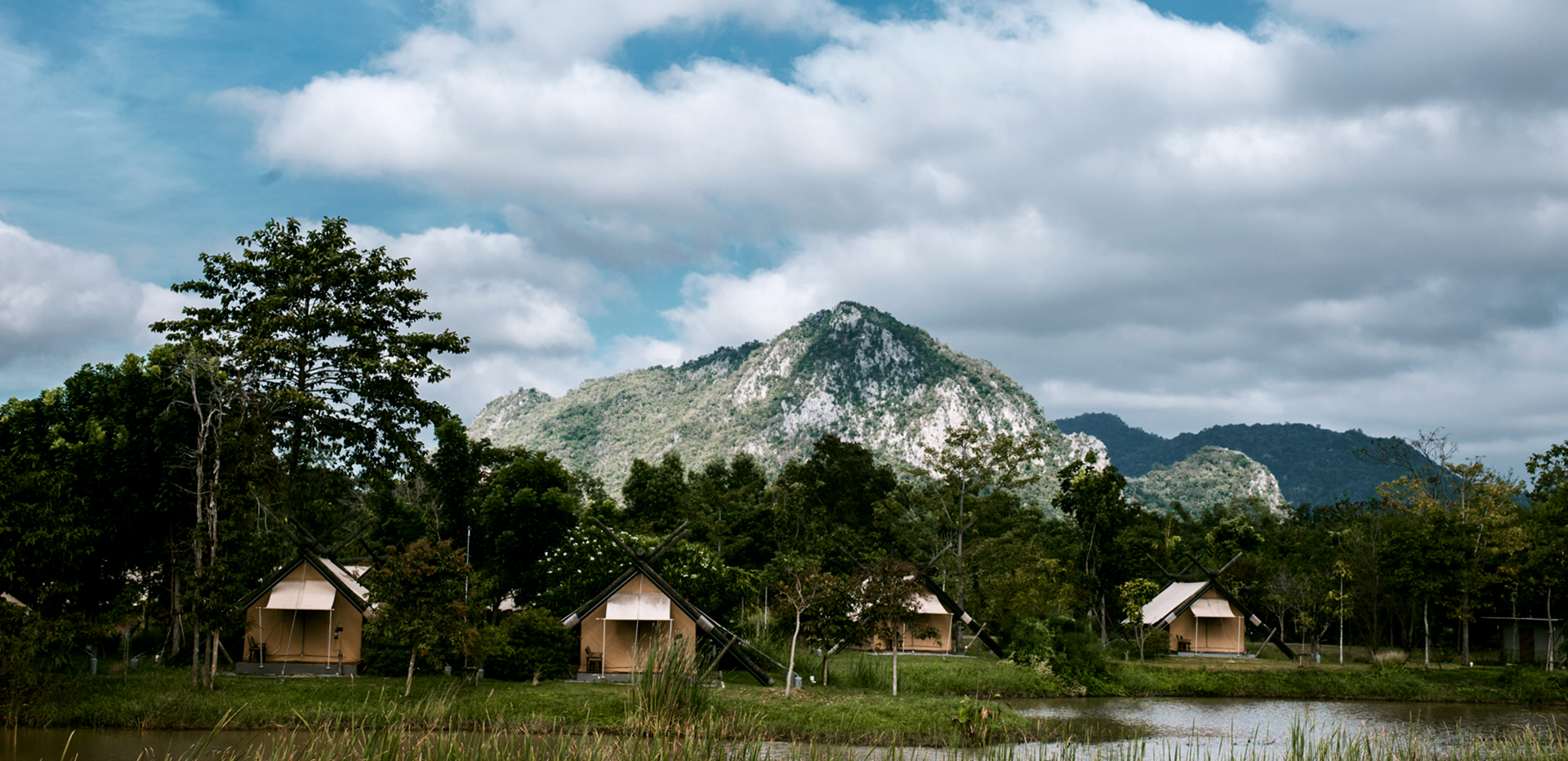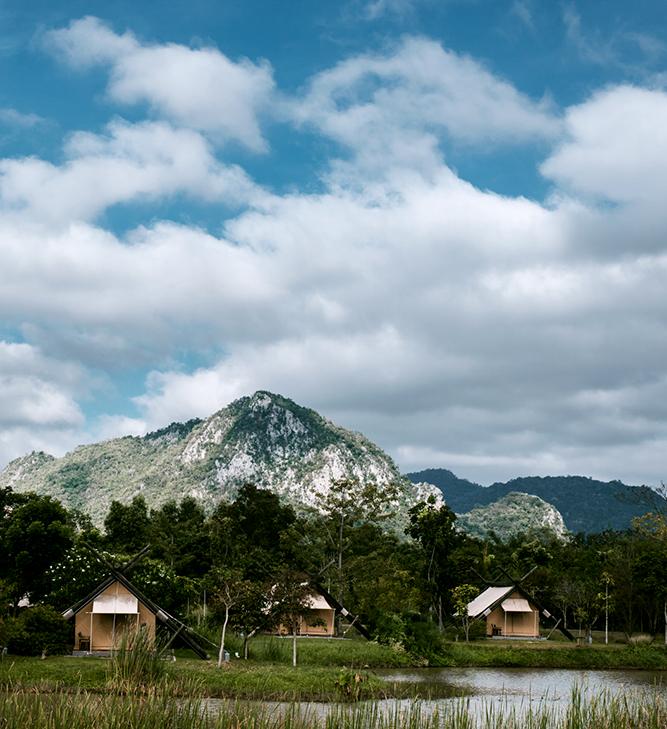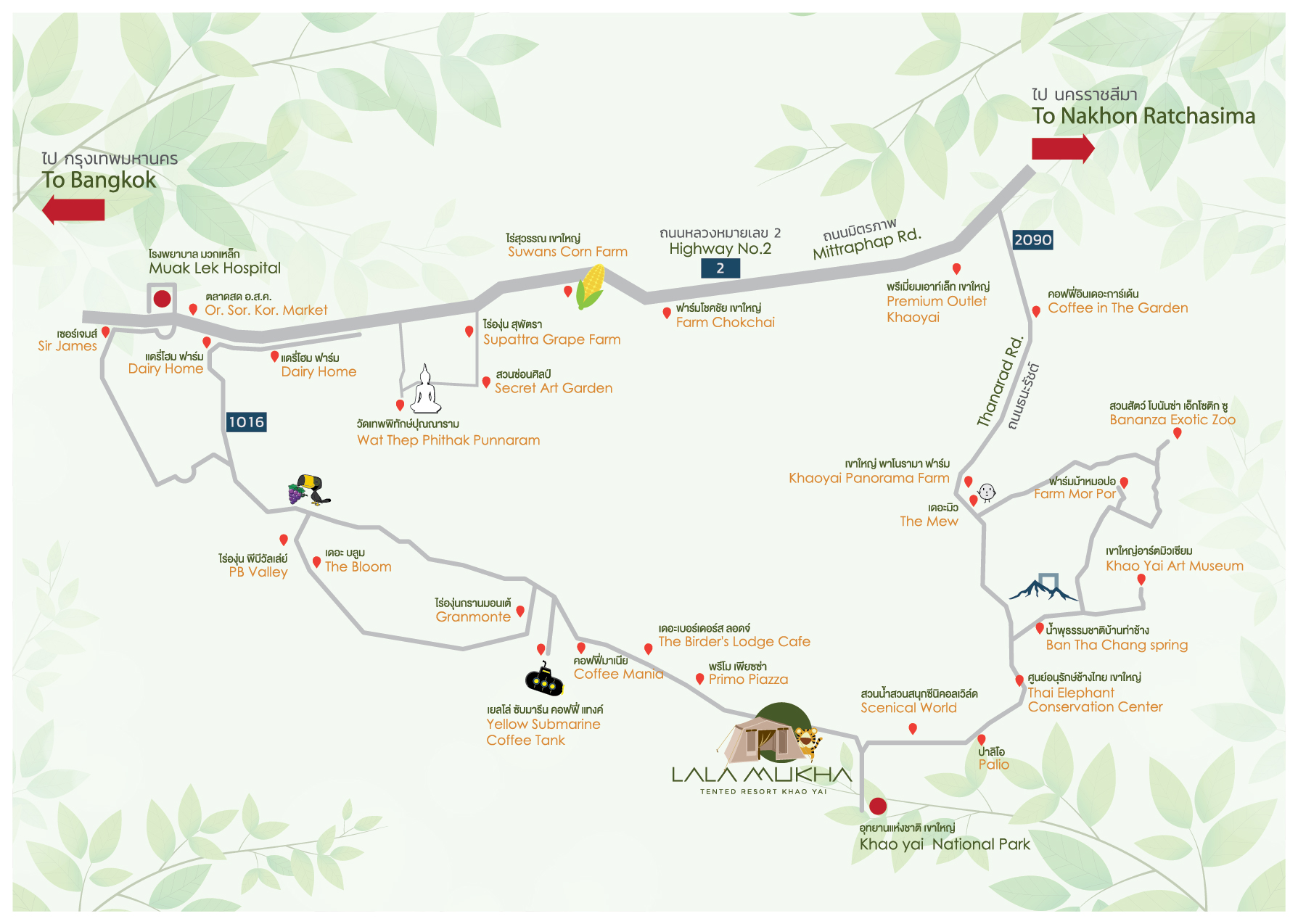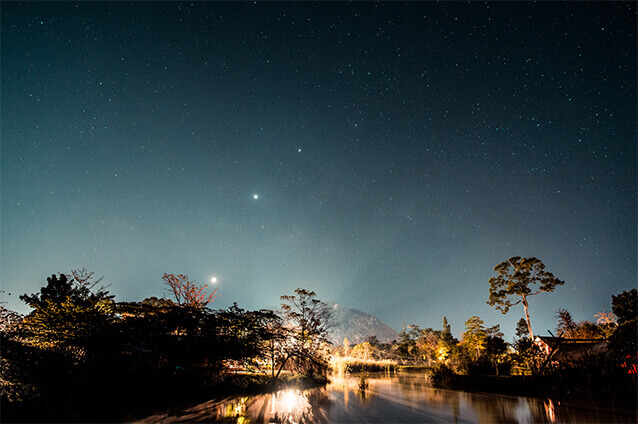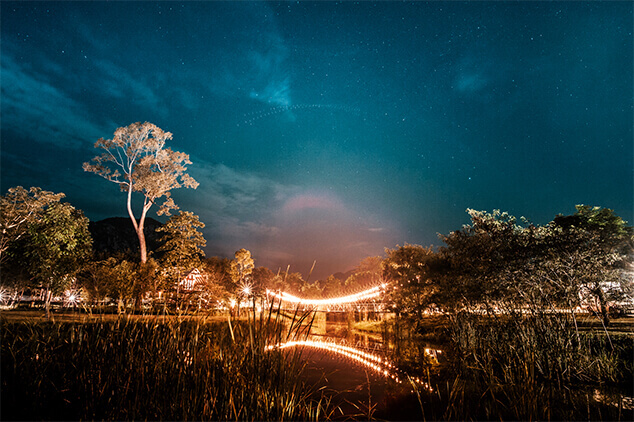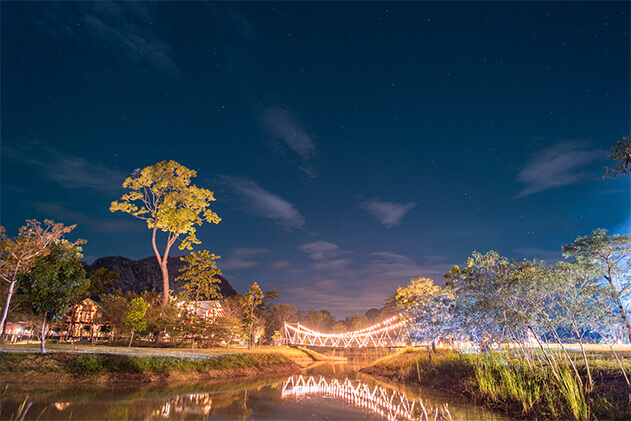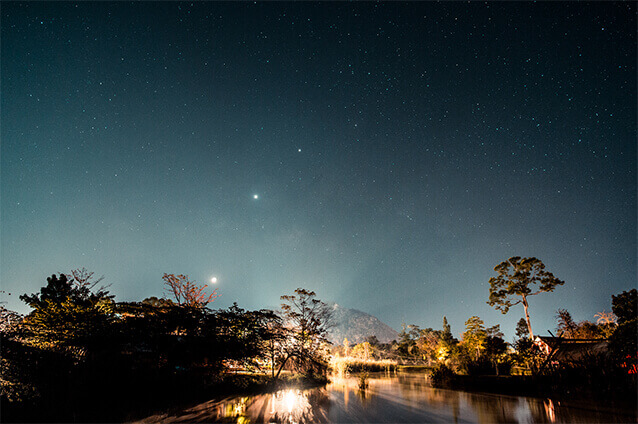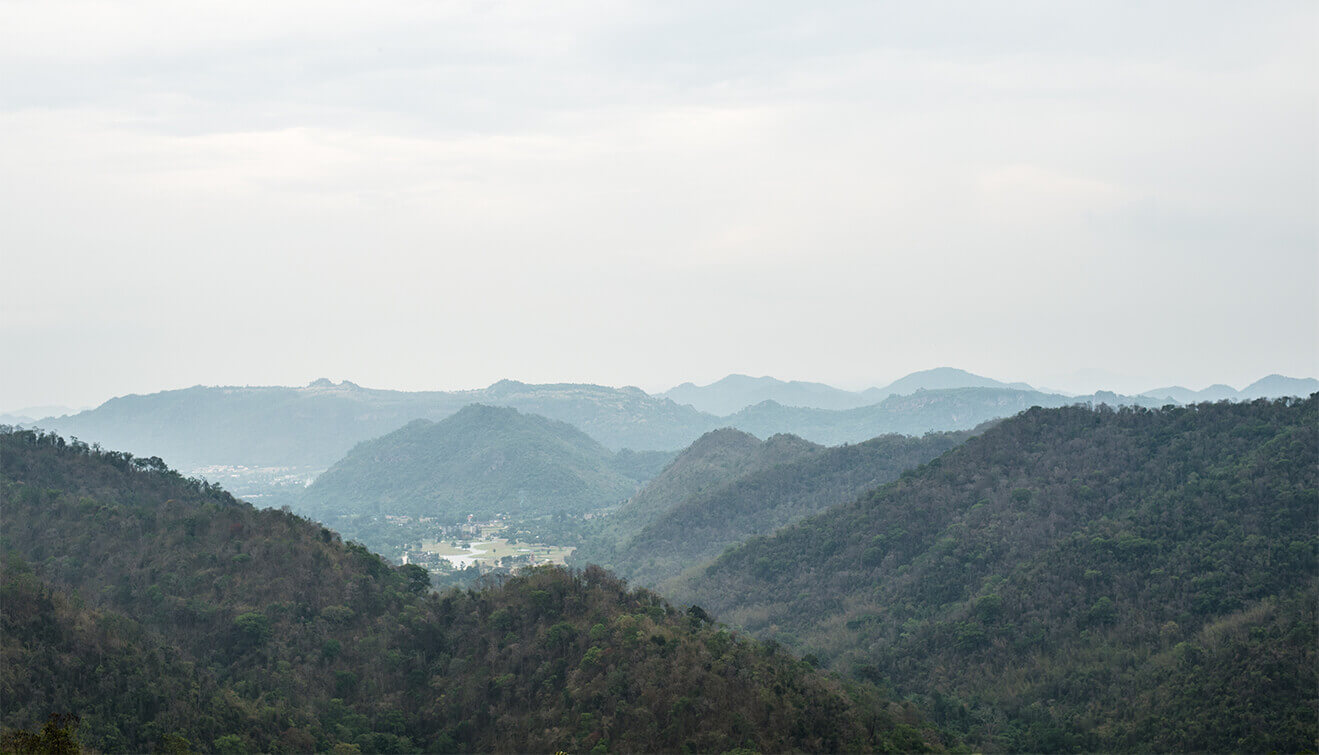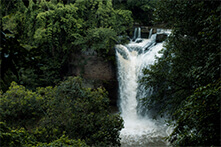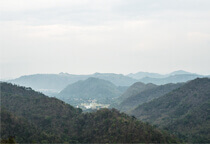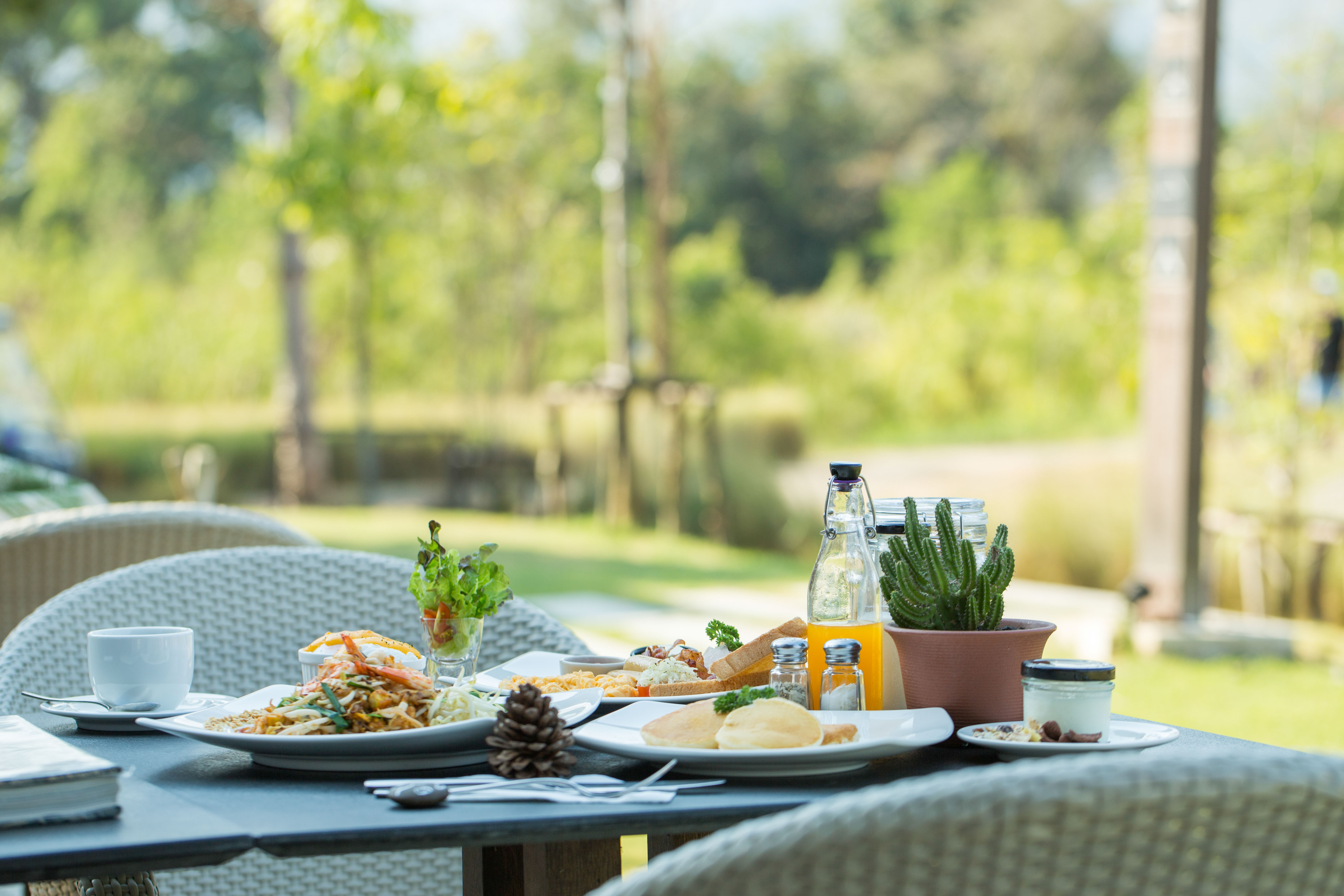LOCATION
Set directly at the Kud-Kla Junction. We are located in Mu-Si District within short walking distance to the nearby Kud-Kla Village. Lalamukha is an unspoiled part of Thailand ecologically and geographically integrated with the adjacent Khao Yai National Park, 3.6 km before the Park’s entrance.
178 KM
from the north east of Bangkok which is approximately a 2.5 hours drive-away.
Distance from Airports to Lalamukha
From Don Muang Airport: 155 km, approximately 2 hr 26 mins by car
From Suvarnbhumi International Airport: 182 km, approximately 2 hr 54 mins by car
HOW TO GET THERE
BY CAR | PRIVATE
From-To : Bangkok-Mu Si Village
Duration : 2 hrs approximately
-
Via Thanarat Road
Take the route no. 31 expressway to the north, bypassing Don Muang International Airport and then turn right to route no. 1 (Phahon Yothin). Go pass Wangnoi and Nongkare until you reach the junction, then turn right Route no. 2 in Saraburi. Turn right to route no. 2 (Mitraparp Highway) and passing by Thapkwang, Kaeng Khoi, Muak Lek, Klang Dong tol Mittraphap and Thanarat Road Junction. Turn Right to Thanarat Road (route no. 2090) and drive to Mu Si Junction. Turn right to Pansuk-Kudkla Road (route no. 1016) and drive for another 200 meters. The resort is on the left.
-
Via Pansuk-Kudklar Road
Take the route no. 31 expressway to the north, bypassing Don Muang International Airport and then turn right to route no. 1 (Phahon Yothin). By passing Wangnoi, Nongkare to the junction to Route no. 2 in Saraburi. Turn right to Route no. 2 and passing by Thapkwang, Kaeng Khoi, Muak Lek to Klang Dong and make a U-turn at Km 39 to get to Pansuk-Kudklar Road (route no. 1016). After U-Turn, it will take approximately 3 km and turn left to reach Pansuk-Kudklar Road. The “Daily Home Restaurant” will be at the corner and drive to Mu Si Junction. The resort is on the right, 200 meters before the junction, approximately 25 kms after turn left.
-
Via Pansuk-Kudklar Road
Take the route no. 31 expressway to the north, bypassing Don Muang International Airport and then turn right to route no. 1 (Phahon Yothin). By passing Wangnoi, Nongkare to the junction to Route no. 2 in Saraburi. Turn right to Route no. 2 and passing by Thapkwang, Kaeng Khoi, Muak Lek to Klang Dong and make a U-turn at Km 39 to get to Pansuk-Kudklar Road (route no. 1016). After U-Turn, it will take approximately 3 km and turn left to reach Pansuk-Kudklar Road. The “Daily Home Restaurant” will be at the corner and drive to Mu Si Junction. The resort is on the right, 200 meters before the junction, approximately 25 kms after turn left.
BY BUS | PUBLIC SERVICE
From-To : Bangkok - Pak Chong Town
Duration : 3 hrs approximately
Scheduled air-conditioning buses leaving MOCHIT BUS TERMINAL every 1 hours around the clock to Pak Chong are available at around THB 200 per person. After arriving “Tesco Lotus” department store, Pak Chong branch, walk to the nearby McDonald for a refreshment while waiting for the resort’s pick up. Kindly contact the resort at 044 300 691 to arrange your pick up on arriving Pak Chong. From Pak-Chong, there is an easy driving distance of 20 minutes to reach the resort.
Pick-up time and Drop off time:
- 11:00 AM and 02:00 PM with no charge
- call the resort to pick-up any time at 250 Baht / person
BY MINI VAN | PUBLIC SERVICE
From-To : Bangkok - Pak Chong Town
Duration : 3 hrs approximately
Scheduled air-conditioning mini vans leaving VICTORY MONUMENT, Southern exit of BTS Station, near Century Plaza every hour from 05:00 AM are available at around THB 180 per person. The mini van will leave the passengers at Pak Chong City. Kindly contact the resort at 044 300 691 to arrange your pick up on arriving Pak Chong. From Pak-Chong, there is an easy driving distance of 20 minutes to reach the resort.
Pick-up time and Drop off time:
- 11:00 AM and 02:00 PM with no charge
- call the resort to pick-up any time at 250 Baht / person
BY PRIVATE TRANSFER
From-To : Bangkok - Resort
Duration : 2 hrs approximately
Advanced reservation Private transfer in 5-10 seat van can be arranged on guest’s request at approximately THB 5,000 for picking up at your hotel to the resort and to be available for leisure during the day. Kindly contact the resort at 044 300 691 for reservation.
We wish you a safe journey and we look forward to welcoming you to LALAMUKHA
WILD FACTS
As part of our commitment to nature, forest fields and grassland are our neighbors. Lalamukha supports over hundred species of birds, variety of reptile as well as small animals such as bats, small rodents, amphibians and invertebrates such as spiders, scorpions and insects. We have over 80 species of trees and many more shrubs and glass species.
There is the season that you can have a pleasant experience with our neighbors and nature.
- Butterflies season May-July
- Cricket / cicada season March
- Dragonfly June-July
- Bat Daily at dusk between 05:45-06:30 PM
- Fruit season March-April, July (Mango, Tamarind, Custard apple, Rambutant, Durian)
- Bombax ceiba flowers Jan-Feb
- Moon November
- Star and Meteor shower May 6-7, July 30-31
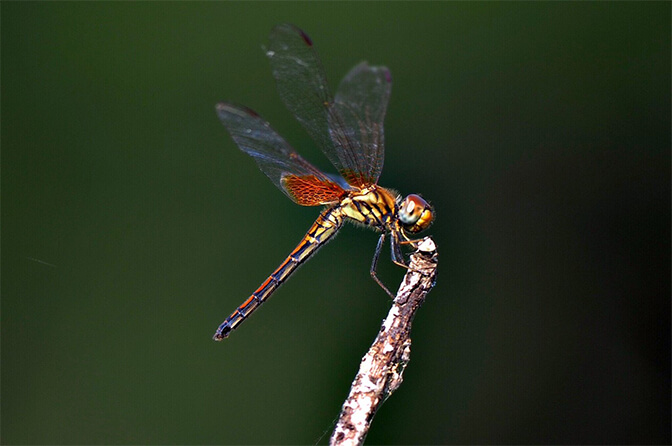
MEDICAL SERVICES
24-hour on-site first aids assistance is available at the resort. Local pharmacy store is only 340 meters far from the resort which is approximately 4 min by walk.

CLINIC AND
HOSPITALS
For small care, a medical clinic “The Bangkok hospital clinic – Khaoyai” is 550 meters away from the resort (7 min by walk). It opens daily from 08:30 AM-07:00 PM. Tel: 044-300-422
For serious medical care, there are three major hospitals nearby with an international standard as follows
HOSPITAL
PAK-CHONG TOWN
Bangkok Hospital
27.5 km distance from the resort | 29 minutes by car | Telephone 044 429 999
Pak-Chong Na Na Hospital
22.1 km distance from the resort | 22 minutes by car | Telephone 044 312 568
MUAK LEK TOWN
Muak lek hospital
27 km distance from the resort | 27 minutes by car | Telephone 036 341 560
The hospital transfer can be arranged through either hospital emergency ambulance or resort vehicle.
USEFUL INFORMATION
LALAMUKHA TRAVEL
SEASON INFORMATION
Any time of year is a good time to visit Lalamukha, as each season has its own charm. There are three main seasons in Khao Yai area with an annual mean temperature of 23 degree Celsius during the day dropping to 13 degrees Celsius at night (source: www.khaoyaiguild.com) The average annual percentage of humidity is 74.0%.
Hot season in our area is rather pleasant comparing to other area in Thailand. Rain is rather common with 10-12 days per month. The average day temperatures is in the high twenties and the night temperatures a bit below twenties degrees. At KHao Yai Natiional Park, these months seem to be the best for watching the rare, world’s largest wild cattle species, the Gaur. There is no guarantee, but they frequent tend to go to the grasslands usually after sunset.
Rainy season has an average day temperature in the mid twenties. Especially after the rain, the late afternoon can be quite cool. Night temperatures are a bit lower than in the hot season. This is the best time to visit the waterfalls. All Khao yai area is surrounded by the lush trees and misty mountains. The most windy month is seen in August and September is the most humid month.
Both hot and rainy season are a time when the bush is green, lush and thick. Overall atmosphere is humid but fresh.
Cold season is the dry months, the bush is less dense and with a lack of water, animals visit the waterholes more often. The mountains turn to yellow. However, the winter season is pleasant due to the average day temperatures in the low twenties, though, the night temperatures can drop to ten degrees Celsius. In general sunny days, clear blue skies. The least humid month is in February. Nonetheless, it is not good season to visit waterfall.
The average temperatures of each season are as follows:
| Hot Season | Mar - Apr | Average during the day Average at night |
20-30°C 17°C |
Humid |
| Rainy Season | May - Oct | Average during the day Average at night |
27°C 13°C |
High Humid |
| Cold Season | Nov - Feb | Average during the day Average at night |
22°C 9-10°C |
Clear and sunny sky |
source: www.thainationalparks.com/khao-yai-national-park, www.khaoyaitours.wordpress.com
THINGS TO BRING
TO LALAMUKHA
- Long trousers and completely informal dress, neutral colors recommended. Raincoat (Rainy seasons)
- Windbreaker or sweater or light jacket for winter and night safaris
- Comfortable walking or hiking or sport shoes
- Swimming costume – our resort has a cool pool
- Sunscreen lotion
- Sunhats and sunglasses
- Camera, video camera and binoculars
- Motion sickness relief
THINGS WE PROVIDE
AT LALAMUKHA
- Umbrella
- Insect repellent
- Bottled water
STARGAZING
Is there anything more beautiful than a sky full of stars? Unfortunately, many of us who live in cities are unable to observe the beauty of the night sky because the high levels of light pollution obscure many stars from view. KhaoYai is one of the best places in Thailand where you can enjoy breath-taking views of the stars, the Milky Way, and the moon. As a nature-oriented getaway destination, one of the highlights for many of our guests is a chance to observe the stunning views of glory night sky.
Stargazing has been a popular timeless hobby and a simple way to bring science alive for children and share with them the beauty of the natural world. Even during our childhood as boy or girl scouts, stargazing is one of survivor and familiar night activities to navigate us back to base camp. With breakthroughs in science and technology have allowed us to view and appreciate the stars like never before. Taking the time to look up at the night sky is a memorable experience, which everyone in the family can enjoy.
What to know before stargazing
- Stargazing is best done before the moon is full.
- The night sky is constantly changing, depending on the time of year and the time of night. Try stargazing throughout the year to spot seasonal constellations.
- Download an app like Star Walk or Sky Map or Google Sky to your mobile or tablet, and they will tell you what stars you can see from your current location. You can also install Stellarium or Star map on your mobile phone and use it to explore the skies near you.
What to bring with you
- Something to lie on such as blanket or camping mat
- Binoculars to allow us to see hundreds more stars than the naked eye
- Snack, drink and warm clothes to keep children happy and warm as you wait for the stars to come out. On a cold night, hot chocolate can help stargazers keepwarm.
- As the sun sets, you could tell your children campfire story of ancient myths about the stars and tales of space exploration with the background of space-themed songs from your iPod.
- A compass to help you find a particular constellation or star.
- Your camera to capture the wonder on the faces of stargazers or the stars above.
At Lalamukha, we are away from city lights, means boundless stargazing opportunities, regardless of the season. Most winter nights are cloudless and thousands of stars are visible to the naked eye.
BIRDING
AT LALAMUKHA
The hot months of March and April are a great time for bird watching in Lalamukha and Khaoyai National Park. The varying habitats at Lalamukha such as open grass plains, thick bush offer exciting bird watching for our guests. Almost hundred species have been recorded at Lalamukha including rare specimen. Birds and their diversity play an important role to the balance of nature and studying birdlife is a part of wonderful safari experience during your stay with us.
The followings are some information on three of our most fascinating and popular birds.
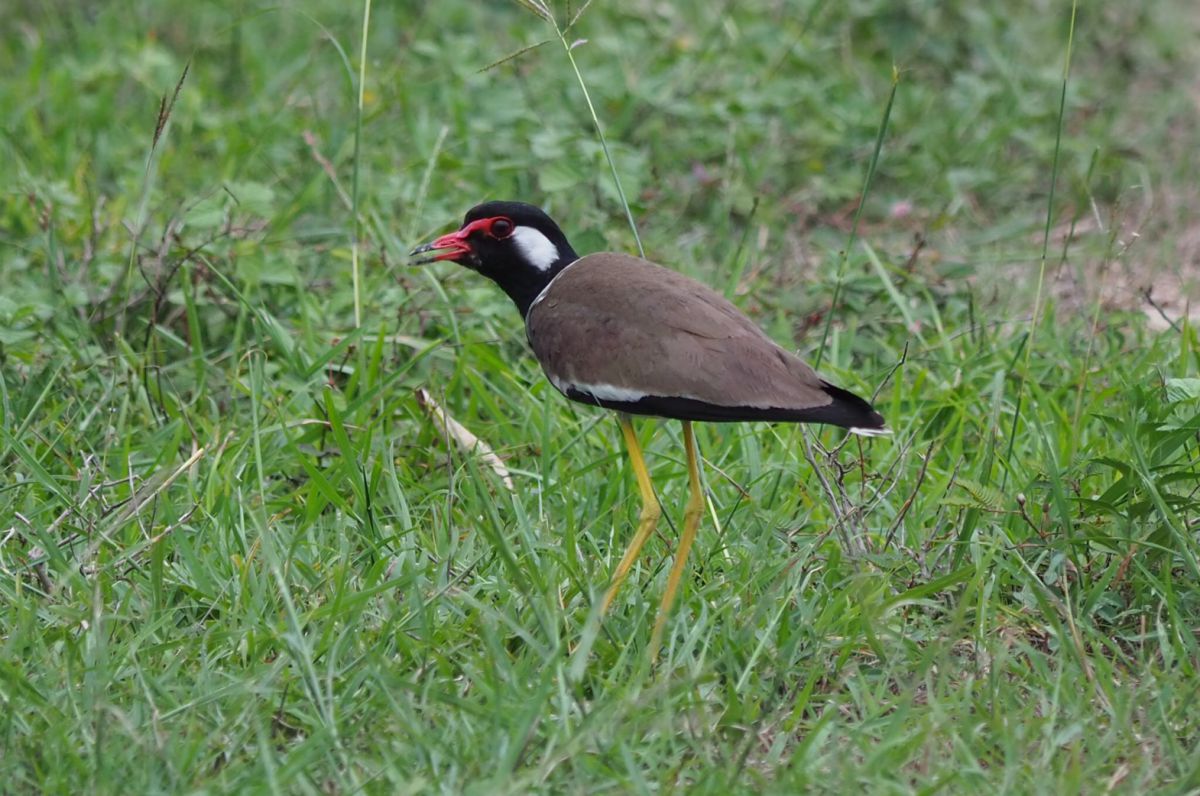
Red-wattled Lapwing (source: en.wikipedia.org)
During your stay at Lalamukha, you will familiar with the sound of red-wattled lapwing. The red-wattled lapwing is an Asian lapwing or large plover. Like other lapwings they are ground birds that are incapable of perching. Their characteristic loud alarm calls are indicators of human or animal movements and the sounds have been variously rendered as did he do it or pity to do it leading to the colloquial name of did-he-do-it bird. Usually seen in pairs or small groups and usually not far from water they sometimes form large aggregations in the non-breeding season (winter). They nest in a ground scrape laying three to four camouflaged eggs. Adults near the nest fly around, diving at potential predators while calling noisily. The cryptically patterned chicks hatch and immediately follow their parents to feed, hiding by lying low on the ground or in the grass when threatened.
Red-wattled lapwings are large waders, about 35 cm (14 in) long. The wings and back are light brown with a purple to green sheen, but the head, a bib on the front and back of the neck are black. Prominently white patch runs between these two colors, from belly and tail, flanking the neck to the sides of crown. Short tail is tipped black. A red fleshy wattle in front of each eye, black-tipped red bill, and the long legs are yellow. In flight, prominent white wing bars formed by the white on the secondary coverts.
Its striking appearance is supplemented by its noisy nature, with a loud and scolding did-he-do-it call, uttered both in the day and night.
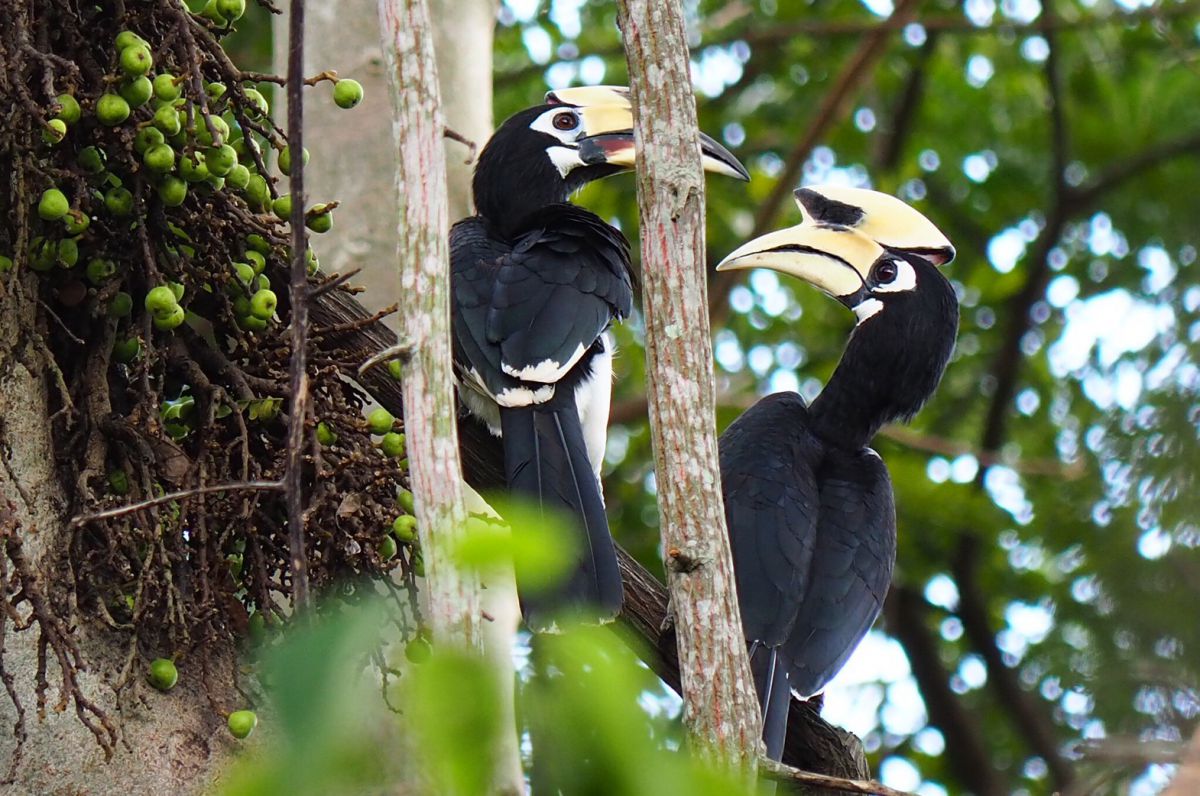
Oriental Pied Hornbill (source: en.wikipedia.org)
The oriental pied hornbill is considered to be among the smallest and most common of the Asian hornbills. It has the largest distribution in the genus and is found in the Indian Subcontinent and throughout Southeast Asia. Its natural habitat is subtropical or tropical moist lowland forests. The oriental pied hornbill's diet includes fruit, insects and small reptiles.
The oriental pied hornbill is a medium size frugivore with a head-to-tail length of 55–60 cm and a wingspan of 23–36 cm. The bill measures 19 cm for males and 16 cm for females. It can weigh between 600 g and 1,050 g, averaging 900 g for males and 875 g for females. The plumage of the head, neck, back, wings and upper breast is black with a slight green sheen. The tail is black with white tips on all the feathers except the central feathers (rectories). The plumage of their lower breast, lower abdomen, thighs, under-wing and all the tips of the wings except the three basal secondaries and two outer primaries is white, as is the circumorbital skin around the eyes and on the throat skin.
The calls of the oriental pied hornbill have been described as crow like sounds, braying sounds or harsh crackles and screeches
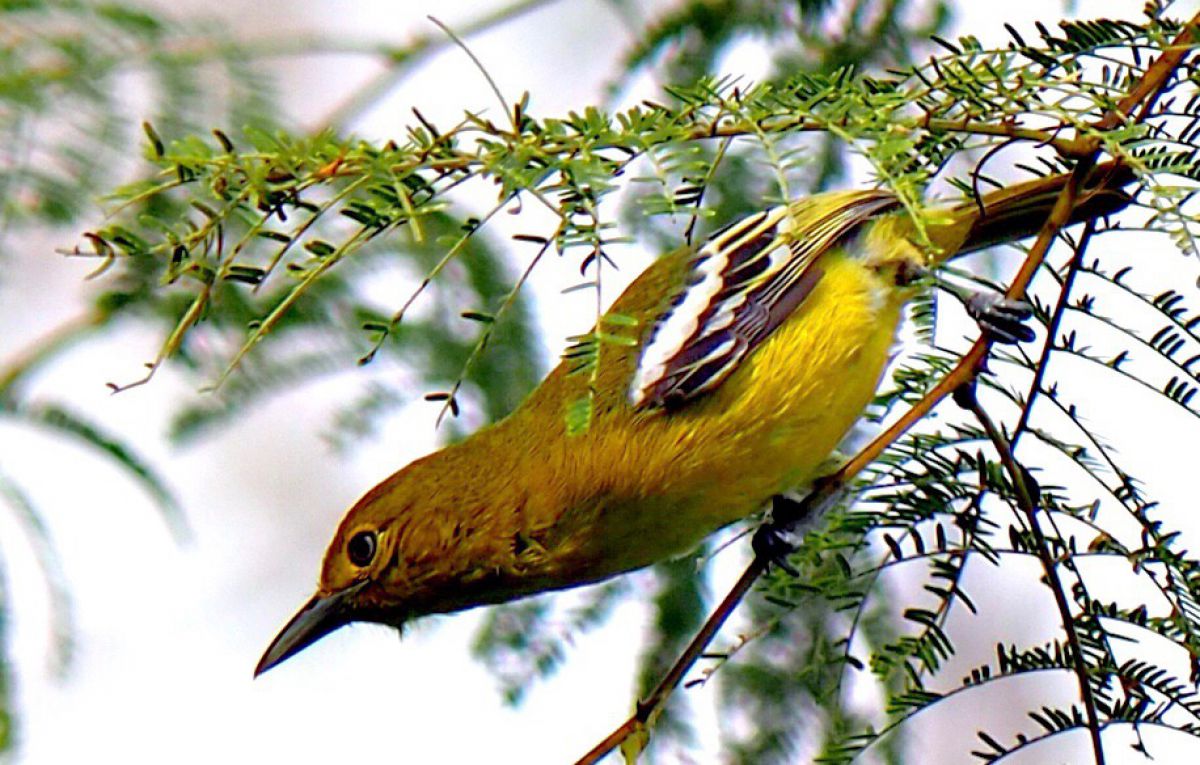
Baya Weaverbirds (source: en.wikipedia.org)
The baya weaver (Ploceus philippinus) is a weaverbird found across the Indian Subcontinent and Southeast Asia. Flocks of these birds are found in grasslands, cultivated areas, scrub and secondary growth and they are best known for their hanging retort shaped nests woven from leaves. These nest colonies are usually found on thorny trees or palm fronds and the nests are often built near water or hanging over water where predators cannot reach easily. They are widespread and common within their range but are prone to local, seasonal movements mainly in response to rain and food availability.
Among the population variations, five subspecies are recognized. The nominate race philippinus is found through much of mainland India while burmanicus is found eastwards into Southeast Asia. The population in southwest India is darker above and referred to as subspecies travancoreensis.[2]
Other birding
There are almost hundreds of resident species at Lalamukha encompassing all types of birds – from seed eaters to insect eaters to those large enough to catch snakes, small rodents. Daily sights include the various glossy starling birds, sunbirds, bulbuls, canaries, hornbill, thick-knees, lapwings, and plovers to name just a few. These following birds are often seen in the resort: Common myna , Golden-fronted leafbird, Yellow-vented flower pecker, Eared pitta, Blue pitta, Scaly-breasted partridge, red headed trogon, White-crested, Black and buff woodpecker, Grey-headed woodpecker, Thick-billed green pigeon, Orange-headed thrush
Birding tips when visit Lalamukha
- get up extra early
- make use of binoculars,
- bring the birding check list and a cup of coffee
- sit back, relax and enjoy the bird song!
OVERVIEW
Khao Yai National Park is situated in the western part of the Sankamphaeng Mountain Range, at the southwestern boundary of the Khorat Plateau. The highest mountain in the area of the park is 1,351 m high Khao Rom. As a UNESCO World Heritage Site, Khao Yai is full of wildlife and jungles which is becoming one of the most popular destinations in the country.
Being a nature-oriented getaway destination, Khao Yai offers little when it comes to nightlife although a handful of resorts may have a bar area that stays open until late. The feel is more relaxed and chilled out with soft music in the background or none at all, which makes sense since most visitors come to Khao Yai for its nature and wildlife instead of a wild party.
Guests are highly suggested to spend ½ day to explore the park for fresh air and by-the-nature experience.
The park is the third largest in Thailand. It covers an area of 2,168 square kilometers, including evergreen forests and grasslands. Its altitude mostly ranges from 400 to 1,000 m above sea level. There are 3,000 species of plants, 320 species of birds like red jungle fowl and coral-billed ground-cuckoo and 66 species of mammals, including Asiatic black bear, Asian elephant, gaur, gibbon, Indian sambar deer, pig-tailed macaque, Indian muntjac, dhole, and wild pig. Although evidence of tiger presence has not been recorded recently, monitoring by FREELAND Foundation in collaboration with Department of National Park rangers has discovered tigers (the Indochinese tiger subspecies) in other parts of Eastern Thailand where they were previously thought to have been completely extirpated. Its waterfalls include the 80 metre Heo Narok, and Heo Suwat made famous from the film “The Beach”.
Khao Yai National Park has three main seasons, with an annual mean temperature of 23° Celsius, though this varies greatly with the seasons.
-
Rainy season (May–October):
Most days have high rates of precipitation. The atmosphere is humid with average temperatures of 27° C during the day dropping to 13° C at night. Streams at peak flow.
-
Cold season (November–February):
Clear skies, sunny and cool. Average temperatures of 22° C during the day and 10° C at night. Good time for hiking.
-
Hot season (March–April):
Humid with daytime temperatures of 20–30° C and 17° C at night.
The park is often visited by travelers from North East (Isan), Bangkok and beyond. There are per-day fees for visitors and vehicles with concessions for Thais or Thai residents.
- Food is available from private concessions within the park.
- Kayaking and rafting services are available in Prachinburi province, in the far southeast of the park.
- Night-time "wildlife spotlighting" is available via pick-up trucks in the early evening. Possible animal sightings include deer, civets, night jars, porcupines, and occasionally even elephants or other more rare nocturnal creatures.
- Slide shows at the visitor center are available on weekends and public holidays.
- Meeting rooms are available with audio visual equipment for seminars and workshops.
- Camping is permitted in camping zones.
- Lodges and cabins are available for singles and groups. Reservations are required.
- There are over 50 km of hiking trails. From easy to hard, one hour to three days. The trails on the map from the visitor center will only have the easier trails. Maps do come with English instructions. A guide is recommended for most trails if the tourist has no experience.
- Observation towers at Nong Pak Chee or Mo Sing. Early morning is the best time to view the Great hornbills, gaur, and sometimes elephants. Gibbons are most active in the early morning.
- At about 17:30 thousands of wrinkled lipped bats emerge from a cave 3 km outside the northern gate to begin night time feeding. The bats fly in a ribbon pattern across the sky.
- Klong Pa Kang-Wang Haew-Dinosaur Footprint. Four-day trek to see a dinosaur footprint.
-
Waterfall must visit in Khao Yai
- Haew Narok Waterfall - The Haew Narok waterfall is the largest waterfall in the park. It is a three-tiered structure that extends 150 meters from the top tier to the basal lake. The waterfall is located about 10 kilometers from the south gate along the central road through Khao Yai.
- Haew Suwat Waterfall - This waterfall runs over a 20-meter cliff into a large pool below. It is located about 8 km to the east of the visitor center and can be visited easily by car along one of the main easterly roads. It can also be reached by an 8 km hike from the visitor center (walk number 4) which takes about 4–7 hours. It is made up mainly of multiple layers of sandstone conglomerates with large interbeds of basalt.
- Haew Sai Waterfall - Haew Sai Waterfalls is located 700 meters north of the Haew Suwat Waterfalls. It is 8 km east of the visitor centre and can also be reached via car or hiking.
- Haew Pratoon Waterfall - Smaller waterfall that is about 1 km north of Haew Sai waterfall.
Entrance Fee
Khao Yai National Park is situated in the western part of the Sankamphaeng Mountain Range, at the southwestern boundary of the Khorat Plateau. The highest mountain in the area of the park is 1,351 m high Khao Rom. As a UNESCO World Heritage Site, Khao Yai is full of wildlife and jungles which is becoming one of the most popular destinations in the country.
Being a nature-oriented getaway destination, Khao Yai offers little when it comes to nightlife although a handful of resorts may have a bar area that stays open until late. The feel is more relaxed and chilled out with soft music in the background or none at all, which makes sense since most visitors come to Khao Yai for its nature and wildlife instead of a wild party.
Guests are highly suggested to spend ½ day to explore the park for fresh air and by-the-nature experience.
The park is the third largest in Thailand. It covers an area of 2,168 square kilometers, including evergreen forests and grasslands. Its altitude mostly ranges from 400 to 1,000 m above sea level. There are 3,000 species of plants, 320 species of birds like red jungle fowl and coral-billed ground-cuckoo and 66 species of mammals, including Asiatic black bear, Asian elephant, gaur, gibbon, Indian sambar deer, pig-tailed macaque, Indian muntjac, dhole, and wild pig. Although evidence of tiger presence has not been recorded recently, monitoring by FREELAND Foundation in collaboration with Department of National Park rangers has discovered tigers (the Indochinese tiger subspecies) in other parts of Eastern Thailand where they were previously thought to have been completely extirpated. Its waterfalls include the 80 metre Heo Narok, and Heo Suwat made famous from the film “The Beach”.
Khao Yai National Park has three main seasons, with an annual mean temperature of 23° Celsius, though this varies greatly with the seasons.
-
Rainy season (May–October):
Most days have high rates of precipitation. The atmosphere is humid with average temperatures of 27° C during the day dropping to 13° C at night. Streams at peak flow.
-
Cold season (November–February):
Clear skies, sunny and cool. Average temperatures of 22° C during the day and 10° C at night. Good time for hiking.
-
Hot season (March–April):
Humid with daytime temperatures of 20–30° C and 17° C at night.
The park is often visited by travelers from North East (Isan), Bangkok and beyond. There are per-day fees for visitors and vehicles with concessions for Thais or Thai residents.
- Food is available from private concessions within the park.
- Kayaking and rafting services are available in Prachinburi province, in the far southeast of the park.
- Night-time "wildlife spotlighting" is available via pick-up trucks in the early evening. Possible animal sightings include deer, civets, night jars, porcupines, and occasionally even elephants or other more rare nocturnal creatures.
- Slide shows at the visitor center are available on weekends and public holidays.
- Meeting rooms are available with audio visual equipment for seminars and workshops.
- Camping is permitted in camping zones.
- Lodges and cabins are available for singles and groups. Reservations are required.
- There are over 50 km of hiking trails. From easy to hard, one hour to three days. The trails on the map from the visitor center will only have the easier trails. Maps do come with English instructions. A guide is recommended for most trails if the tourist has no experience.
- Observation towers at Nong Pak Chee or Mo Sing. Early morning is the best time to view the Great hornbills, gaur, and sometimes elephants. Gibbons are most active in the early morning.
- At about 17:30 thousands of wrinkled lipped bats emerge from a cave 3 km outside the northern gate to begin night time feeding. The bats fly in a ribbon pattern across the sky.
- Klong Pa Kang-Wang Haew-Dinosaur Footprint. Four-day trek to see a dinosaur footprint.
- Waterfall must visit in Khao Yai
- Haew Narok Waterfall - The Haew Narok waterfall is the largest waterfall in the park. It is a three-tiered structure that extends 150 meters from the top tier to the basal lake. The waterfall is located about 10 kilometers from the south gate along the central road through Khao Yai.
- Haew Suwat Waterfall - This waterfall runs over a 20-meter cliff into a large pool below. It is located about 8 km to the east of the visitor center and can be visited easily by car along one of the main easterly roads. It can also be reached by an 8 km hike from the visitor center (walk number 4) which takes about 4–7 hours. It is made up mainly of multiple layers of sandstone conglomerates with large interbeds of basalt.
- Haew Sai Waterfall - Haew Sai Waterfalls is located 700 meters north of the Haew Suwat Waterfalls. It is 8 km east of the visitor centre and can also be reached via car or hiking.
- Haew Pratoon Waterfall - Smaller waterfall that is about 1 km north of Haew Sai waterfall.
Khao Yai Popular Trekking Trails
|
Trail 1 |
Visitor Center – Kong Kaew Waterfall | 1.2 Km | 1 Hr walking time Trailhead starts near the swing bridge behind the visitor center. It is a concreted trail with interpretation boards. The terrain is slightly steep but safe to trail without guide. |
|
Trail 2 |
Orchid Campsite – Haew Suwat Waterfall | 3 Km | 2 Hrs walking time From the campsite, the trailhead is located at the end of the parking lots. Arriving Haew Suwat Waterfall, the finishing point is near the restaurant and souvenir shop. It is a concreted trail, easy to follow and safe to trail without guide. |
|
Trail 3 |
KM 33 – Nong Pak Chi wildlife watchtower | 3.3 Km | 2 Hrs walking time The trailhead is next to the park main road at Km 33 (7 Km from the Head Quarter). There is a small car park. The end of the trail passing is about 200 meters along the dirt road back to the main road again. The trail is good for impressive big trees and wildlife. |
|
Trail 4 |
Dong Tiew – Mo Sing To (Sai Sorn Reservoir) | 2.7 Km | 1.30 Hrs walking time The trailhead is located across the road just south (uphill) from the Head Quarter’s main restaurant. At the first intersection, turn left to follow the trail down through a mosaic of scrubby secondary forest and grassland to the dam wall of Mo Sing To or Sai Sorn Reservoir. Cross the dam wall to return to the park main road. |
|
Trail 5 |
Dong Tiew – Nong Pak Chi wildlife Watchtower | 5 Km | 3 Hrs walking time The trailhead is located across the road just south (uphill) from the Head Quarter’s main restaurant. After about 2.5 Km reaching an area of grassland and secondary forest overlooking Khao Keow mountain. There is junction here. Take the left down through the forest to Nong Pak Chi Watchtower. From this point, walk about 1 Km along the dirt road to the card park. Walk or hitch hiking about 2 Km to the visitor center. This trail is good for wildlife gazing. |
|
Trail 6 |
Visitor Center – Haew Suwat Waterfall | 8 Km | 5 Hrs walking time The trailhead is located either by the swing bridge behind the visitor center or by the swing bridge above Kong Kaew Waterfall. The terrain is steep in some places. Falling trees and streams provide obstacles to cross. Arrange pick up by car from the car park at Haew Suwat Waterfall or hitch hiking back to the Head Quarter. |
Night Safari in Khao Yai
The Khao Yai Night Safari is one of the most popular things to do in the Khao Yai National Park. This activity runs every evening and arranges by the Park itself at Visitor Center. There are two rounds per night at 19:00 PM and 20:00 PM and takes at least an hour and a half per round. The park ranger will drive open-sided truck – approx. 10 persons/truck - around the park using spotlights to look for night wildlife of many animals. The park ranger will drive to salt lick, a good chance to see wild elephants.
The most important thing to take with you for Night Safari is mosquito repellent and a warm jacket or sweater.
Nonetheless, it is highly chance that you will not see many of exotic animals due to more than 50 trucks with shining spotlights will drive along together which may make wildlife stay far away. However, it is fun to sit on an open-sided truck and be driven thousands of feet up into the mountains. The air is cold and clean. The night sounds are fun with a beautiful night sky of shining moon or stars.
Night safari fee will be as follows:
| Night Safari Fee : | join with others | THB 50.00 /person |
| private | THB 500.00 /truck (10 persons) | |
| Transportation fee to Visitor Center : | Rental fee | THB 1,500.00 /truck (24 persons) |
| Vehicle entrance fee | THB 100.00/truck (24 persons) | |
| Park Entrance Fee : | same as above | |
| Vehicle Entrance Fee (bring you own) : | same as above |
